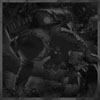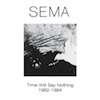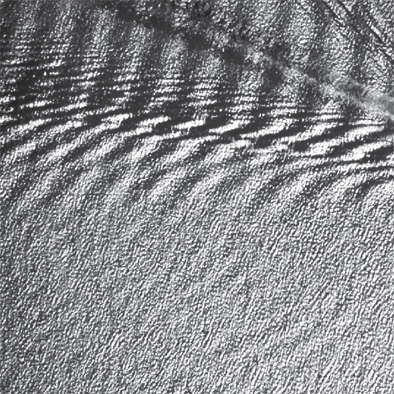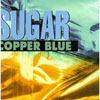23five This two-disc compilation coincides with last year's SFMOMA exhibit ofthe same name, a "listening event documenting the past 18 years ofJapanese experimental music," though this recording features mostlyelectronic-oriented material from the past few years. Despite this, itsbreadth is exceptional and some of the tracks are unreleased, so it'sexcellent both for collectors or as an introduction.
This two-disc compilation coincides with last year's SFMOMA exhibit ofthe same name, a "listening event documenting the past 18 years ofJapanese experimental music," though this recording features mostlyelectronic-oriented material from the past few years. Despite this, itsbreadth is exceptional and some of the tracks are unreleased, so it'sexcellent both for collectors or as an introduction.
Noise, of course, is a focal point, and each of the several noisepieces are quite distinct—Pain Jerk's track is a rumbling, rhythmicassault in contrast to Masonna's brighter vocal and synth-drivenfreakout. The Otomo Yoshihide track, consisting only of high frequencyguitar feedback, is easily the toughest; he exploits the subtleinteraction of two tonally pure sustained notes, holding them foruncomfortable lengths of time. It's interesting and challenging but Iprefer his more dynamic work.
Other tracks range from minimalist-inspired rhythmic clicks, such asthe Nerve Net Noise, Atau Tanaka, and Ryoji Ikeda tracks, which allmanage to distinguish themselves with their detailed but disarminglysimple tonal palettes, to more abstract, juxtaposed medleys. MasahiroMiwa's contribution uses plaintive low-fi synths to establish tension;though the sounds are light and playful, the overall feel is heavy andworks well with his stated topic of youth violence in Japan. I likeI.d.'s supposedly "hacker"-inspired piece. Its discrete bundles ofstatic and waves of digital noise sound almost like information, and itslowly develops into something vaguely repetitive and structured.
The compilation also features a few notable older but forward-lookingpieces. Yasunao Tone's track is about contrasts: beauty and ugliness aswell as ancient and modern, combining gorgeous flute playing and anoisy synth that sounds like the creaking of a door. The music stopsperiodically for an NPR-type voice to read some semi-decent poetry;although the track is long and generally simple, it's still engagingand I love the flute playing.
The Kazuo Uehara composition, dating back to 1988, has the mostimpressive sounds on the disc. It begins with some quiet, indeterminateevents and some mumbled French with a cavernous echo, and the vocalsgrow increasingly processed and alien. Stunning woodwind-like dronesbuild towards an organ-like range and later into hauntingly serenehowling and whistling. The ground that this compilation covers, as awhole, is amazing, and it definitely reaffirms the brilliance ofJapanese musical innovation.
samples:
- Otomo Yoshihide - Composition For Two Guitars
- I.d. - Oo.>>..>>..Bt
- Masahiro Miwa - Alleleuia


 This compilation, released to accompany an SFMOMA exhibit, collectseleven tracks from Australian experimental musicians. There's anexcellent sense of unity, as most of the compositions are aestheticallysimilar, at least superficially, in their emphasis on sparse,laptop-driven presentations. Some rely on organic instruments andothers on homebuilt electronics, but all of them find creative soundsand work really well, making this album quite consistent.
This compilation, released to accompany an SFMOMA exhibit, collectseleven tracks from Australian experimental musicians. There's anexcellent sense of unity, as most of the compositions are aestheticallysimilar, at least superficially, in their emphasis on sparse,laptop-driven presentations. Some rely on organic instruments andothers on homebuilt electronics, but all of them find creative soundsand work really well, making this album quite consistent. 'Style Drift' couldn't be a more appropriate title for this,Fontanelle's long-awaited sophomore full-length, as the band don'tnecessarily shift their style but improve enough to make a noticeabledifference. Recorded again in their Magnetic Park studio, 'Drift' is areal step forward for the band, as their confidence improves and theirarrangements gain strength and weight. For improvisation-based music,it doesn't get any better than this, and Fontanelle are reaching anapex where their version will be instantly recognizable. As always, thedrumming is tight, the bass a propulsive mass, and the wah-wah guitartasty. The keys, different types, are more ingrained than before, andcreate a mood and feel all by themselves, often with layered effectsand computer gimmicry applied to them. The band has become tighter, asperfectly evidenced on the breaks in the title track. There's adefinite jazz vocabulary at work, too, that only serves to improve theproceedings. Overall, though, the spirit in Fontanelle is inmaniupulation. There are sounds on this record that are new for theband, as they reach out towards the outer limits. Imagine, if you will,that the Max Rebo Band fired Sy Snoodles and got a hold of a fewTortoise records and you wouldn't be far off. Fontanelle have alwaysbeen amazing musicians, but on this release they are in the pocketevery time, working together better than ever, and proving that thereis longevity and consistency in doing it all off the cuff.
'Style Drift' couldn't be a more appropriate title for this,Fontanelle's long-awaited sophomore full-length, as the band don'tnecessarily shift their style but improve enough to make a noticeabledifference. Recorded again in their Magnetic Park studio, 'Drift' is areal step forward for the band, as their confidence improves and theirarrangements gain strength and weight. For improvisation-based music,it doesn't get any better than this, and Fontanelle are reaching anapex where their version will be instantly recognizable. As always, thedrumming is tight, the bass a propulsive mass, and the wah-wah guitartasty. The keys, different types, are more ingrained than before, andcreate a mood and feel all by themselves, often with layered effectsand computer gimmicry applied to them. The band has become tighter, asperfectly evidenced on the breaks in the title track. There's adefinite jazz vocabulary at work, too, that only serves to improve theproceedings. Overall, though, the spirit in Fontanelle is inmaniupulation. There are sounds on this record that are new for theband, as they reach out towards the outer limits. Imagine, if you will,that the Max Rebo Band fired Sy Snoodles and got a hold of a fewTortoise records and you wouldn't be far off. Fontanelle have alwaysbeen amazing musicians, but on this release they are in the pocketevery time, working together better than ever, and proving that thereis longevity and consistency in doing it all off the cuff. Add N to (X) have a fantastic formula. Catchy post-punk hooks played onprimal synths coupled with a powerful drummer works well in dirty andloud live settings. The band puts on some of the best shows I've hadthe privilige to see over the last couple years. Their biggestchallenge at this point is to take some of that raw live energy andchannel it into their recordings so there's less wishy-washy tunes thatsimply meander all over the place. Like all of their records, there aresome really awesome moments here. I'm partial to the Meat Beat-ishsampled drum shuffle on "Elecrtic Village," the new wave of snottypost-punk vocals of "Large Number," and the campiness of the album'sopener, "Total All Out Water." There are numerous low points, however.The "I Hate Her/She Hate Me" vocals on "Sheez Mine" and spoken word on"Invasion of the Polaroid People," sound completely convictionless andcould have easily been omitted from the album altogether. Theundeniable hit, "Quantum Loop," has a strong enough hook to carry thetune but the random scattering of samples seems like a poorly plannedafterthought. Even the album's single, "Take Me To Your Leader," kindof fizzles after only a minute or so. While I'm not looking for them torecreate some of my fave tunes from the last five years, ("MetalFingers in My Body," or "Plug Me In" still get me as excited as thefirst time I heard them) there is an increasing lack of strong tunesand completed thoughts this time around.
Add N to (X) have a fantastic formula. Catchy post-punk hooks played onprimal synths coupled with a powerful drummer works well in dirty andloud live settings. The band puts on some of the best shows I've hadthe privilige to see over the last couple years. Their biggestchallenge at this point is to take some of that raw live energy andchannel it into their recordings so there's less wishy-washy tunes thatsimply meander all over the place. Like all of their records, there aresome really awesome moments here. I'm partial to the Meat Beat-ishsampled drum shuffle on "Elecrtic Village," the new wave of snottypost-punk vocals of "Large Number," and the campiness of the album'sopener, "Total All Out Water." There are numerous low points, however.The "I Hate Her/She Hate Me" vocals on "Sheez Mine" and spoken word on"Invasion of the Polaroid People," sound completely convictionless andcould have easily been omitted from the album altogether. Theundeniable hit, "Quantum Loop," has a strong enough hook to carry thetune but the random scattering of samples seems like a poorly plannedafterthought. Even the album's single, "Take Me To Your Leader," kindof fizzles after only a minute or so. While I'm not looking for them torecreate some of my fave tunes from the last five years, ("MetalFingers in My Body," or "Plug Me In" still get me as excited as thefirst time I heard them) there is an increasing lack of strong tunesand completed thoughts this time around. On their third full length album, the duo of AJ Cookson and Matthew Rozeik that somehow managed to merge the disparate worlds of black metal and hard-edged electronic dance music have put together another brilliant combination of the two, sounding like no one else in the process, in the best possible way.
On their third full length album, the duo of AJ Cookson and Matthew Rozeik that somehow managed to merge the disparate worlds of black metal and hard-edged electronic dance music have put together another brilliant combination of the two, sounding like no one else in the process, in the best possible way. An ambient side project from Dean Costello (Harpoon, Diatribes, Winters in Osaka), Cosmic Despair is a perfectly titled album: a long suite of guitar and organ bleakness, with just a hint of psychedelia to keep it different and unexpected.
An ambient side project from Dean Costello (Harpoon, Diatribes, Winters in Osaka), Cosmic Despair is a perfectly titled album: a long suite of guitar and organ bleakness, with just a hint of psychedelia to keep it different and unexpected. With a notable recent string of high profile collaborations with Aidan Baker and Yellow6, guitarist Eric Quach has been continually refining his abstract take on ambient drone, and on this four track solo cassette, his ability at generating unique, alien noises from the stalwart instrument is clearly on display, as is his skill for composition as well.
With a notable recent string of high profile collaborations with Aidan Baker and Yellow6, guitarist Eric Quach has been continually refining his abstract take on ambient drone, and on this four track solo cassette, his ability at generating unique, alien noises from the stalwart instrument is clearly on display, as is his skill for composition as well. Whenever asked about reissuing his old material, the standard line from Robert Haigh has always been that because the original masters had been lost there was no chance of a reissue. So it came as a bit of a shock when Vinyl On Demand announced that they were releasing a box set of Haigh’s work as Sema this year. Although there is no unreleased material included, the scarcity of all this music means that there is nothing to complain about. This is complete collection of some of the best and criminally unheard music of the 1980s.
Whenever asked about reissuing his old material, the standard line from Robert Haigh has always been that because the original masters had been lost there was no chance of a reissue. So it came as a bit of a shock when Vinyl On Demand announced that they were releasing a box set of Haigh’s work as Sema this year. Although there is no unreleased material included, the scarcity of all this music means that there is nothing to complain about. This is complete collection of some of the best and criminally unheard music of the 1980s. I absolutely loved Jakobsons' last solo album (Darwinsbitch's Ore), but her many collaborative releases since then have varied quite a bit in both style and quality.  Recently, however, she has been on a definite hot streak, as both Myrmyr's Fire Star and the Espvall/Jakobsons/Szelag album were pretty amazing.  Glass Canyon does not quite keep that impressive momentum going, but there are enough flashes of inspiration to make it an intermittently satisfying effort nonetheless.
I absolutely loved Jakobsons' last solo album (Darwinsbitch's Ore), but her many collaborative releases since then have varied quite a bit in both style and quality.  Recently, however, she has been on a definite hot streak, as both Myrmyr's Fire Star and the Espvall/Jakobsons/Szelag album were pretty amazing.  Glass Canyon does not quite keep that impressive momentum going, but there are enough flashes of inspiration to make it an intermittently satisfying effort nonetheless. Twenty years after its initial release, the debut Sugar album remains one of my favorite albums of the 1990s as well as one of my favorite rock albums of all time. After establishing himself as an accomplished singer/songwriter with two solo albums following the breakup of seminal Hüsker Dü, Bob Mould launched Sugar, now brought back to life through an exceptionally amazing package by Edsel out now in the UK (and an okay version due from Merge later this month).
Twenty years after its initial release, the debut Sugar album remains one of my favorite albums of the 1990s as well as one of my favorite rock albums of all time. After establishing himself as an accomplished singer/songwriter with two solo albums following the breakup of seminal Hüsker Dü, Bob Mould launched Sugar, now brought back to life through an exceptionally amazing package by Edsel out now in the UK (and an okay version due from Merge later this month).
